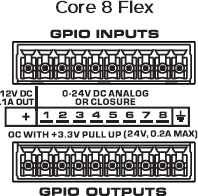GPIO In (Core 8 Flex, I/O-8 Flex)
The General Purpose Input/Output (GPIO) connections allow the Q-SYS network to interface with miscellaneous outside devices, such as LED indicators, switches, relays, and potentiometers, and with custom or third-party controls.
Note: Refer to the Using GPIO Inputs and Outputs technical note on the QSC website to learn how to configure GPIO on the I/O-8 Flex.
The GPIO allotment on the Core 8 Flex and I/O-8 Flex totals eight inputs and eight outputs. Configure each independent input and output in the Properties pane.
Flanking each row of eight GPIO inputs and outputs is a +12V DC terminal and a ground or reference terminal that can be used for potentiometers (input), relay coils and LEDs (output), and other uses. The +12V pins use a self-resetting fuse and each has up to 100 mA available.


GPIO-1 to 8
Select the Type of GPIO input:
- Digital Input (TTL 3.3V)
- Contact Closure Input
- Potentiometer (10k Ohm, 12V)
- Potentiometer (2-wire)
- Analog Input (0-24V, low z)
- Raw
Digital Input (LED)
This LED illuminates when there is a digital input on a GPIO pin. Each of the following Types of input has an LED to indicate a digital input is present:
- Digital Input (+3.3VDC)
- Contact Closure – When this type is selected, the pin has approximately 9.5VDC present, the LED is lit.
- Raw
Analog Input (Knob)
The analog input knob is provided when one of two Input Types is selected.
- Analog – allows a low impedance, 0 – 24VDC low z signal input
- Raw
Both input voltages are displayed on a read-only knob control.
Potentiometer - Min Position, Calibrate Min, Max Position, Calibrate Max
The Potentiometer knob follows the position of the physical potentiometer connected to the GPIO pin. To calibrate Q‑SYSto the potentiometer:
- Turn the physical potentiometer to its minimum position.
- Click the Calibrate Min button. A value displays in the Min Position field.
- Turn the physical potentiometer to its maximum position.
- Click the Calibrate Max button. A value displays in the Max Position field.
If you know the values for Min Position and/or Max Position, you can enter them manually.
Pullup Enable
Provides a 5.11K Pullup resistor to +12VDC on the input pin when the Type is Raw.
|
Pin Name |
Value |
String |
Position |
Pins Available |
|---|---|---|---|---|
|
Digital Input |
0 1 |
false true |
0 1 |
Output |
|
Contact Closure |
0 1 |
false true |
0 1 |
Output |
|
Potentiometer |
0 to 1.00 |
0 to 1.00 |
0 to 1.00 |
Output |
|
Calibrate Maximum 1 |
0 1 |
false true |
0 1 |
Input |
|
Calibrate Minimum 1 |
0 1 |
false true |
0 1 |
Input |
|
Maximum Position 1 |
0 to 1.00 |
0 to 1.00 |
0 to 1.00 |
Input / Output |
|
Minimum Position 1 |
0 to 1.00 |
0 to 1.00 |
0 to 1.00 |
Input / Output |
|
Analog Input (Knob) |
0 to 24 | nn.nnnV | 0 to 1.00 | Output |
|
Raw |
|
|
|
|
|
Digital Input (LED) |
0 1 |
false true |
0 1 |
Output |
|
Analog Input (Knob) |
0 to 24 | nn.nnnV | 0 to 1.00 | Output |
|
Pullup Enable |
0 1 |
false true |
0 1 |
Output |
1. These control pins are selectable in the Control Pins list at the bottom of the GPIO selections. You must select the Type (Potentiometer or Raw) to make these Control Pins accessible. |
||||
